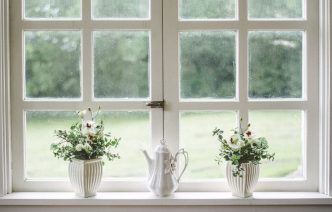The History of Stained Glass Windows
The purpose of most windows is to allow a view of the outside and admit light into a building. The purpose of stained glass windows, however, is not to allow people to see outside, but to beautify buildings, control light, and often times to tell a story. Many believe that stained glass was first created by ancient Egyptians and/or the Romans, both of whom largely excelled in the making of small colored glass objects. During the Medieval period, stained glass window making flourished, reaching its peak during the Gothic period, in which stained glass windows were used in cathedrals; stained glass window making persisted into the Renaissance period, but declined at the end of this period. Today, there has been a revival in the popularity of stained glass.
Origins
The origins of stained glass are not certain, but ancient Egyptians were probably the first people to discover glass while making their vessels; the oldest examples of man-made glass are Egyptian colored glass beads from around 2700 BC. Stained glass windows were first used by well to do Romans in their homes in the first century AD. Early examples of stained glass windows can also be found in some of the palaces and mosques in the Middle East. In Jarrow, England at St. Paul’s Monastery, some of the oldest pieces of a stained glass window from 686 AD were found; the earliest stained glass piece presenting a picture is a head of Christ from the 10th century, discovered at the Lorsch Abbey in Germany.
How Stained Glass Windows Were Made
To make stained glass, artisans mixed potash and sand to 3000 degrees Fahrenheit and added various metallic oxide powders to create different colors. The glass was then flattened into sheets while it was still pliable. The artists would have a blue print, or what they called a cartoon, of the design of the window on a large board-the sheets of glass would be laid on top of the blue print and cut into the approximate sizes needed. The pieces were finished by grozing. Sometimes, details were painted onto the stained glass windows with a special paint made from ground glass and iron filings that were suspended in urine or wine; this mixture helped block light and define designs. The finished pieces of glass were fitted into H-shaped strips of lead called cames. The cames were soldered together to create panels, which were then put into a frame made of iron called an armature; at this point the window was complete and ready to be put in the wall.
Medieval History
The stained glass windows that are familiar today did not come about until the 10th century, with the construction of Gothic cathedrals. The oldest complete stained glass windows were those of Augsburg Cathedral in Germany, constructed in the late 11th century. The Medieval church funded most of the stained glass windows of the time. Abbot Suger of Saint Denis was a famous patron of stained glass art and lived just outside of Paris. He used the wealth of the abbey to make windows larger and more beautiful, because he considered light the manifestation of God himself. Subjects of stained glass windows being made during this time were mostly religious in nature and served to tell Biblical stories to lay people that could not read, as well as beautifying the churches. It has been speculated that the stained glass windows probably had a more profound impact on the people than the sermons themselves. Some of the windows used obscure symbolic icons that scholars of today study to learn about daily life of the time. Gothic windows were generally tall and spear-, wheel-, or rose-shaped. A good example of Gothic stained glass windows are those of the Notre Dame chapel, which holds one of the largest rose shaped windows in the world.
Renaissance
The primary subjects of Renaissance windows were still Biblical, but they are dressed in Renaissance style clothing. The scenes still featured symbolic imagery, perhaps even more so than in the Gothic period. At this time, even non-religious scenes were included in church windows. Stained glass was used in buildings like town halls and wealthy homes, although the panels of homes were small and usually just painted on. The use of linear perspective is seen in some works and activity taking place far in the back, while other activity occurs close up front. Figures in the pieces show feeling and emotion as the humanist movement of the time made this popular. Artists had to use enamel paint to portray feeling and realism in characters, but this didn’t work well on stained glass, as the windows were too far away to see this detail and the leading which was important to the stained glass artwork, was ignored.
The Decline of Stained Glass Windows
Between the Renaissance and the mid-19th century stained glass windows fell from favor. This was largely due to changes within religious norms of the time – the church had been the supporter of the arts, and the new Protestants did not believe in fancy art work and decoration. By 1640, stained glass was rare and only small panels featuring heraldry were used for homes and city halls. The English Parliament demanded all images of the Virgin Mary and the Trinity be removed from churches, so many stained glass windows were smashed by fanatic vandals. The destruction only stopped because it was too costly to replace the windows. Stained glass window making became a lost art.
Revival Today
It wasn’t until the mid-19th century that the interest in Gothic style was revived all over Europe and in the United States. Artists sought to recreate the lost technique of medieval stained glass windows. John La Farge and Louis Comfort Tiffany were makers of stained glass during the Art Nouveau period, and created opalescent, confetti, drapery, and ridged glass. The windows of Louis Comfort Tiffany, Marc Chagall, and Frank Lloyd Wright are fine examples of modern stained glass windows. This revival was cut short by the depression of the 1930’s and 1940’s, which was then followed by WWII. In the last thirty years, interest in stained glass windows has again been revived. Select fine art programs within colleges and universities teach the art of making stained glass and many individual artists have flourished. Stained glass making is also a very popular hobby.
For more information on stained glass windows, please consult these links:
-
Introductory History of Stained Glass: The history of stained glass during the Roman, Gothic, and Renaissance periods is given here.
-
Stained Glass: Some basic information on stained glass and stained glass windows is presented in this article.
-
History of Stained Glass: Follow the history of stained glass from the accidental discovery of glass during ancient times to stained glass post World War II.
-
Stained Glass in Gothic Cathedrals (PDF): Stained windows in 12th century France were used to tell Biblical stories as well as provide beauty to cathedrals.
-
Brief History on Stained Glass Windows: Read about some of the earliest examples of stained glass windows in this brief history.
-
Gothic Cathedrals: Characteristics of Gothic style stained glass windows are given, and several pictures of stained glass windows in Gothic cathedrals are featured.
-
Glass: This article explains how stained glass was made in ancient times and includes a section on stained glass windows.
-
Window Glass: Read a brief synopsis on how to make window panes and stained glass windows.
-
Stained Glass in Medieval Europe: Learn more about how Gothic stained glass windows were made.
-
Sacred Stained Glass: Stained glass windows were more than just windows and art; they contained symbolic messages and illustrated the Bible for lay people who could not read.
-
Images in Light: View images of Gothic stained glass windows and listen to discussions of particular windows on this page from The Getty Museum.
-
Stained Glass in Florence: Learn about Renaissance period stained glass windows in Florence, Italy.
-
The Art of Stained Glass: A history of stained glass is included in this article about the stained glass windows of this university.
-
Stained Glass History (PDF): Explore the history of stained glass and learn about what the different colors symbolized in medieval times.
-
Stained Glass in Short: Read a short explanation of how stained glass windows were made and how methods changed over time.
-
The Language of Stained Glass: Modern American glass studios are discussed, and the symbolism of colors used in stained glass windows.
-
Vitrum: Explore a detailed history of stained glass making and read some interesting stories about its origin.
| Wood Windows and Doors | Additional Window Options | Home Services |
|---|---|---|


